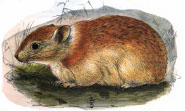 The Afghan pika (Ochotona rufescens), a terrestrial animal, is known for its adaptability to high altitudes. Native to the mountains of the Middle East, this mammal can be found specifically in Pakistan, Iran and its namesake, Afghanistan. The mammal is also indigenous to Armenia and Turkmenistan. Its habitat is rocky desert but is also found in temperate forests and burrowed in dry fields without stones.
The Afghan pika (Ochotona rufescens), a terrestrial animal, is known for its adaptability to high altitudes. Native to the mountains of the Middle East, this mammal can be found specifically in Pakistan, Iran and its namesake, Afghanistan. The mammal is also indigenous to Armenia and Turkmenistan. Its habitat is rocky desert but is also found in temperate forests and burrowed in dry fields without stones.These lagomorphs are small and oval-shaped, with males and females similar in size and weight. Its body is generally grey and brown, with tinges of cream coloring during summer months and heavy brown fur in winter. Eyes are widely set to offer a broad field of vision. The average weight is less than 500 grams (17.6 ounces) while average length ranges from 120 to 300 millimeters (4.7 to 11.8 inches.) Ears are round and large for its body, growing as long as 1.4 inches (36 millimeters). In contrast, both its head and legs are short and its tail barely visible. Because of poor heat dissipation and high body temperatures, the pika easily adapts to cold environments.
Unlike rodents, which have one pair of upper incisors, the Afghan pika has an additional set of upper teeth, but this extra pair is not sharp. Its diet consists of plants native to a dry habitat, including thistles.
Breeding season runs from mid-March to late September with a short gestation period. Newborn pikas are born blind and helpless and either hairless or slightly furred. Weaned after 22 days, pikas become adults within seven weeks of birth. Females can therefore become pregnant fairly young. The average litter ranges from five to seven, with as many as five litters per year. Rock dwellers live longer than their burrowing counterparts, up to seven years versus just two. With a stable population, the Afghan pika may have a population up to 70 per 10,000 square miles.
The Afghan pika is listed as Least Concern (LR/lc), lowest risk. Does not qualify for a more at risk category. Widespread and abundant taxa are included in this category, on the IUCN Red List of Threatened Species

Custom Search